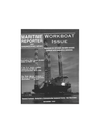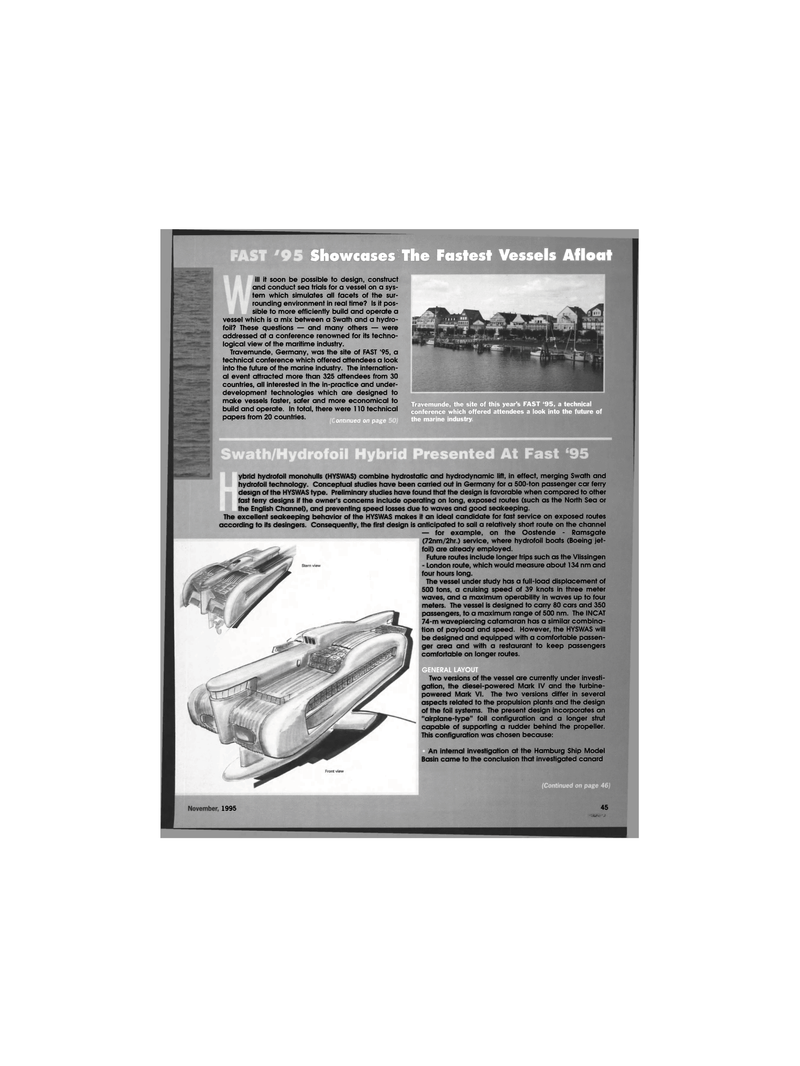
Page 43: of Maritime Reporter Magazine (November 1995)
Read this page in Pdf, Flash or Html5 edition of November 1995 Maritime Reporter Magazine
Showcases The Fastest Vessels Afloat ill it soon be possible to design, construct and conduct sea trials for a vessel on a sys- tem which simulates all facets of the sur- rounding environment in real time? Is it pos- sible to more efficiently build and operate a vessel which is a mix between a Swath and a hydro- foil? These questions — and many others — were addressed at a conference renowned for its techno- logical view of the maritime industry.
Travemunde, Germany, was the site of FAST '95, a technical conference which offered attendees a look into the future of the marine industry. The internation- al event attracted more than 325 attendees from 30 countries, all interested in the in-practice and under- development technologies which are designed to make vessels faster, safer and more economical to build and operate. In total, there were 110 technical papers from 20 countries. onnnuea on page
Travemunde, the site of this year's FAST '95, a technical conference which offered attendees a look into the future of the marine industry,
GENERAL LAYOUT
Two versions of the vessel are currently under investi- gation, the diesei-powered Mark IV and the turbine- powered Mark VI. The two versions differ in several aspects related to the propulsion plants and the design of the foil systems. The present design incorporates an "airplane-type" foil configuration and a longer strut capable of supporting a rudder behind the propeller.
This configuration was chosen because:
An internal investigation at the Hamburg Ship Model
Basin came to the conclusion that investigated canard ybrid hydrofoil monohulls (HYSWAS) combine hydrostatic and hydrodynamic lift, in effect, merging Swath and hydrofoil technology. Conceptual studies have been carried out in Germany for a 500-ton passenger car ferry design of the HYSWAS type. Preliminary studies have found that the design is favorable when compared to other fast ferry designs if the owner's concerns include operating on long, exposed routes (such as the North Sea or the English Channel), and preventing speed losses due to waves and good seakeeping.
The excellent seakeeping behavior of the HYSWAS makes it an ideal candidate for fast service on exposed routes according to its desingers. Consequently, the first design is anticipated to sail a relatively short route on the channel — for example, on the Oostende - Ramsgate (72nm/2hr.) service, where hydrofoil boats (Boeing jet- foil) are already employed.
Future routes include longer trips such as the Vlissingen - London route, which would measure about 134 nm and four hours long.
The vessel under study has a full-load displacement of 500 tons, a cruising speed of 39 knots in three meter waves, and a maximum operability in waves up to four meters. The vessel is designed to carry 80 cars and 350 passengers, to a maximum range of 500 nm. The INCAT 74-m wavepiercing catamaran has a similar combina- tion of payload and speed. However, the HYSWAS will be designed and equipped with a comfortable passen- ger area and with a restaurant to keep passengers comfortable on longer routes. 1995 45 sfi R , ffi :

 42
42

 44
44
